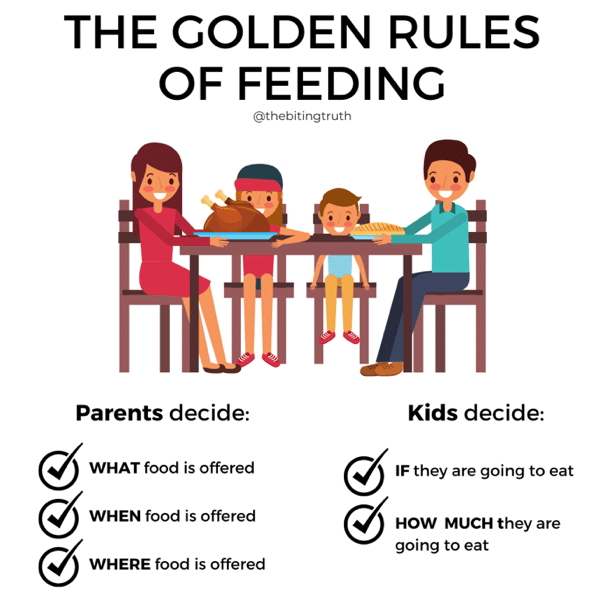
Are you fed up battling with your child at mealtimes?
Frustrated about spending hours in the kitchen only to have your child turn their nose up at your meals?
Confused about the best way to encourage your child to eat?
It’s time to learn about The Golden Rules of Feeding!
Introducing The Golden Rules
The Golden Rules are a science-based approach to mealtimes based on the work of American dietitian and psychotherapist Ellyn Satter, author of the Division of Responsibility in Feeding, which is considered the gold standard to feeding children.
To reduce stress at mealtimes it’s important to have a clear understanding of who’s responsible for deciding what – the parent or the child.

Parents Decide:
- Parents decide what is on the menu at meals and snacks. Instead of catering to your child’s likes and dislikes, prepare one meal for the whole family to avoid encouraging selective eating. When deciding what to offer, ensure you are including at least one ‘safe’ food on their plate that you know they do like. Forget the “no dessert until you finish everything on your plate” mantra you may have been raised on; regardless of what your child chooses to eat from their plate, they should still be offered dessert if it’s on the menu. Using food as a reward can foster an unhealthy relationship with food that may persist into adulthood.
- Parent’s decide when food is offered. The best thing to do is to create a meal schedule and stick to it. This reliability is reassuring for your child – knowing when their next meal will come means they won’t feel the need to overeat when food is available to them.
- Parents decide where food is offered. Offer food to your child at the dinner table, ensuring they are sitting properly, instead of in their bedroom or while playing outside. The table is the perfect spot to practice eating mindfully, responding to hunger and satiety cues, away from distractions. Plus, family meals have loads of benefits for children!
Children Decide:
- Children decide if they are going to eat. If your child decides not to eat, still include them at the dinner table. As hard as it may be, avoid pressuring your child to eat when they choose not to. Children tend to respond by eating less or avoiding those foods they’re being encouraged to eat.
- Children decide how much they are going to eat. Yes, that’s right, your child is the boss of deciding how much food they want to eat. They may polish off one part of the meal and leave the rest untouched or have a little of each component. Whatever your child chooses to do, try to avoid commenting on their, or anyone else’s, food intake; the dinner table should be a judgement-free zone.
Essentially, you provide the occasion for them to eat a healthy and pleasant meal. The offer is theirs to accept, or decline. There should be no further discussion; the roles are clear – kids know what is expected of them and parents do too.
Practising these rules at different ages
- For babies: The Golden Rules are still relevant for babies. At this age you, as the parent, aren’t yet going to be deciding when and where food is offered; responding to baby’s cues is best. Make sure you are letting them choose how much they eat, and never pressuring them to eat more or less than they want.
- For toddlers: As your baby enters toddlerhood, it’s important to begin establishing structured mealtimes. This is when you fully adopt your role of deciding the “what”, “when” and “where” of feeding.
- Older children: Have you already passed toddlerhood? It’s never too late to introduce this approach! We recommend first introducing a mealtime schedule. Let your child know the kitchen will be closed outside of the designated eating times. Once you have implemented this schedule, focus on reducing pressure at mealtimes. Serve your child food you have chosen but include something on their plate you know they will eat.
Examples of how this might play out
Scenario 1 : My child comes to the dinner table most nights and completely refuses to eat.
Solution: Your child is within their right to choose not to eat. We understand you may worry your child will go to bed hungry, but consistency is key, so avoid caving to your child’s pleas for an alternate meal. Remember to include a ‘safe’ food on their plate, something you know they will eat. Their hunger cues will prompt them to eat more at breakfast the next morning, or you may choose to schedule a suppertime snack. You can also offer a small snack before bed such as yoghurt or a piece of fruit. With time and persistence, they’ll enjoy a full dinner.
Scenario 2: When I serve my child dinner, they will usually only eat the carbohydrate component.
Solution: Recall The Golden Rules – it is your responsibility to decide what foods are on your child’s plate, where they eat and at what time. It is completely up to them to choose what they eat. So, if they choose only to eat the pasta or rice etc., that is fine. Make sure there are still veggies and a source of protein on the plate too. If they ask for more, give it to them. To increase variety, try offering a different carbohydrate food each night.
Scenario 3: My child asks for food outside of scheduled mealtimes.
Solution: You may find this happens when you first introduce a mealtime schedule, before your child becomes familiar with it. As difficult as it may be initially, adhering to your scheduled mealtimes will pay off in the long run. As long as you are offering regular, balanced meals and snacks your child’s hunger cues will take care of the rest.
Bottom line
The Golden Rules are a simple approach to making mealtimes less stressful. They can take some time to master, so be patient and consistent because they really do work.
—
Notes
- This article was written by Anna and Alex who are Only About Children‘s Dietitian partners. Original article can be found here.
- For some delicious kid-friendly recipes, click here.
